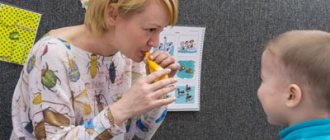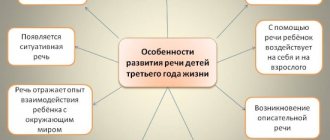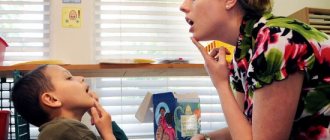The second year of a baby’s life is the stage of primary language acquisition. The pre-speech stage has already been passed, when the baby walked, babbled, and uttered the first sounds. Starting from the age of one year, the baby slowly masters words that are meaningful to him. But, sometimes it happens that a child does not speak at 1.5 years old, although by the age of one year his active vocabulary should have about 6 words. Active vocabulary is the words that he uses in his speech (passive vocabulary is words whose meaning he knows and understands, but he does not pronounce them).
Normal development of children's speech at one and a half years
By the beginning of the second half of the year, children can have from 30 to 50 words in their vocabulary. They use them both of their own free will and as answers to questions from others.
The passive vocabulary by this time has a much larger number of words and concepts. In the next six months, that is, from one and a half to two years, the child gradually transfers words from a passive vocabulary to an active one. This process is growing like an avalanche. Experts call it a “lexical explosion.”
Almost every day children learn new and new words. At the age of one and a half years, many children who have developed speech in accordance with age standards combine two words into one sentence. “Give me a doll” (give me a doll, a cube), “Papa is not there” (dad is not at home), “Baba give me” - here are a few similar sentences from root words. Sometimes children as young as one and a half years use only one-syllable sentences: “Boom,” “Yum-yum,” “Beep.”
If the child’s speech development does not correspond to the average statistical norm (at 1.5 years the baby does not say not only 1-2 word sentences, but also does not say the required number of words, or does not say anything at all), then parents should start stimulating the child’s speech.
Passive and active vocabulary
During this period, attention is drawn to such a characteristic feature as imitation of the words of adults. The baby repeats not only familiar words, but also previously unknown ones. These could be words addressed to the child, or words that he heard from others. Such active imitation can be noticed already from 1 year 5 months. Here it is important not to coo with children, faking your speech in “childish” language, but to give an example of the correct pronunciation of words.
Starting from the first year of life, the understanding of words grows; the baby is familiar with the names of objects in his immediate environment, the names of objects, animals and other objects that are most often shown to him in pictures in children's books, on the street. The baby loves to look at bright colored book illustrations. Adults should maintain this interest by choosing clear pictures.
When commenting on illustrations to a child, you need to speak precisely, in simple words, try to denote the object with one, constant word, so that the meaning of the picture is not lost in the stream of speech of an adult. For example, while the word monkey is used to describe monkeys and gorilla.
By the age of one and a half years, a child’s active vocabulary is 20–30 words; its sound composition is still simple. Thanks to the desire to imitate the speech of adults, by the end of the second year the baby increases the number of spoken words tenfold. Speech is dominated by nouns, but there are also verbs (2-3 times less of them) and adverbs (there, here, here).
Occasionally, by the age of two, the use of adjectives can be found in children's speech; this feature will continue to persist into early preschool age. Personal pronouns are often found in a child’s speech and are easily used (I, you, he, she).
Possible symptoms and causes of speech delay
When caring about the timely development of your child, you should not rely on independently obtained information about the norm and pathology; it is better to trust a specialist. In the age of information technology, you can, even without being a resident of a metropolis, get remote consultation on any issue.
First of all, you need to contact a pediatric neurologist, since speech is a process controlled by the central nervous system. Since speech is a process that took shape later than all mental functions, that is why this fragile formation is the first to suffer from disorders of the central nervous system. In rare cases, late speech development is genetically determined in members of the same family.
In what cases should you consult a neurologist at one and a half years:
- there is no speech at all, or there is incomprehensible babble;
- the child points or shouts when he needs something;
- the baby does not repeat after adults the syllables and simple words “mom, baba, dad, kitty, give, na”;
- speech first appeared and then disappeared.
Before visiting a doctor, you should prepare to provide him with complete information about the course of pregnancy and childbirth. The specialist will be interested in whether there was any pathology of pregnancy, fetal hypoxia, asphyxia during childbirth, when the child cried, his Apgar score, and other similar information.
Possible causes of speech delay:
- incompatibility of the Rh factor of mother and child;
- infectious diseases suffered by a woman during pregnancy, late gestosis in pregnant women;
- birth injuries leading to MMD (minimal cerebral dysfunction), hypoxia, asphyxia of the newborn;
- pedagogical neglect, when children are given insufficient attention;
- head injuries, neuroinfections.
It is quite possible that the parents’ fears will not be confirmed, and speech development proceeds normally, but with a slight delay. However, it is better to take up the prevention and correction of speech disorders in a timely manner than to lament the lost time later. From the age of 2, children can study with a speech therapist and a speech pathologist.
Why may a child not speak at 2 years old?
Normally, upon reaching the age of two, the baby should actively communicate with parents and loved ones, call a spade a spade, and tell various stories. But it happens that a child at 2 years old does not yet utter any words or does it very poorly. The reasons for this may be:
- No need for speech . This can happen in two opposite situations. Firstly, when parents hardly talk to the child, he spends a lot of time in front of the TV or computer - there is simply no one to communicate with. Secondly, when parents try to say everything for the child, predict his desires by gestures and sounds, formulate simple questions that can be answered “yes/no” - then the baby simply has no need to engage in communication.
- Hereditary diseases that are accompanied by speech development delay (SSD)
- The nature of the speech of parents and the environment . If the speech of the adults around the child is fluent, fast, and unclear, then the children are not able to repeat all this.
- Difficult labor (rapid, with entanglement of the umbilical cord) or trauma to the child during birth (trauma to the cervical spine and/or central nervous system) can also lead to delayed speech development in the child
- Severe infections and traumas (psycho-emotional traumas as well) suffered by the child at an early age, which negatively affected the overall development of speech in the child. It is also important to understand that delayed speech development can be an accompanying symptom of more serious diseases, such as cerebral palsy, epilepsy or congenital abnormalities of the central nervous system.
How to see speech development disorder
Before you conduct an independent diagnosis of speech development, you should rule out hearing impairment in your baby. If he does not hear the speech of others well, then he will not be able to reproduce it. Such a check can be carried out by an audiologist or otolaryngologist at the request of the parents. They turn to specialists if children do not use their voice to attract attention, do not react to a loud sound outside their field of vision, and do not turn towards the source of the sound.
An important indicator of the norm is the development of gross and fine motor skills. If the baby is clumsy, in the second half of the year he cannot pick up a small toy with two fingers, draw doodles, or build a small tower of cubes, most likely his motor skills are not well developed.
The easiest way is to check your baby’s understanding of speech, that is, the fullness of his passive vocabulary:
- ask him to fulfill the adult’s request;
- show an object named by an adult, body parts;
- offer to choose one toy named by adults from several.
In conclusion, the condition of the organs of articulation - lips, palate, tongue - is assessed. The tongue may have a shortened frenulum, be too large, or too small. If parents notice that the tongue is trembling, the baby is constantly salivating, and the mouth is always slightly open, perhaps there is no speech due to a neuropathological pathology - dysarthria.
Treatment and correction of speech delay
The Bersenev Medical Center provides comprehensive treatment for delayed psycho-speech development in children. The clinic’s specialists draw up an individual program for the treatment and correction of mental retardation for each individual child. The program includes a set of rehabilitation activities carried out by a pediatric neurologist, massage therapist and speech therapist. A psychologist, a reflexologist and, of course, parents also take part in the treatment.
One of the main tasks of parents is to eliminate the causes that caused the delay in psycho-speech development (this applies to families with an unfavorable environment). Very important points in treatment are attentiveness to the child, moral support and patience, because correction of PVD is a complex and painstaking process.
If you detect the problem in a timely manner and contact a specialist, complete all the appointments and have a good attitude, you are guaranteed to have good results, high effectiveness of treatment, and the fact that ZPRD will not affect your child’s future in any way.
How does auditory speech agnosia differ from sensory alalia?
I’ll tell you a little about the development of speech understanding in ontogenesis. At the age of up to 1 year, priority development occurs in the temporal region of the right hemisphere. That is, the child first of all matures the ability to holistically perceive non-speech (objective) noises (loudness, tonality, source, melody, rhythm, intonation). Non-speech noises also include sounds made by animals. This is the foundation for subsequent understanding of speech, which is why it is so important for children to provide a varied sound environment. As a result, the child develops his first onomatopoeias. In correction, speech therapists also use techniques to distinguish between various object noises to pass this stage of development (if it has been disrupted) and the subsequent formation of speech auditory gnosis.
At the age of about 1-1.2 years, the secondary fields of the temporal cortex of the left hemisphere are activated (they mature completely by 2 years). And in the noise stream the child begins to isolate speech sounds. His onomatopoeias acquire a “human” pronunciation, vocalizations, normative echolalia (repetitions of heard words), and interjections (oh, bang, bam) begin. This is not one sound, but a series of sounds and simple words that can already be used in a familiar context (mom, dad, baba). This is the stage of maturation of speech auditory gnosis. The child does not yet have the ability to understand the polysemy of words; context (necessarily substantive) is important. Immaturity of the secondary fields of the temporal cortex results in speech auditory agnosia . And if this stage has not been passed, then further development of speech understanding does not occur.
Next, the tertiary fields of the cortex mature - this is the zone where the “overlap” of the parietal, temporal and occipital cortices occurs. The so-called TPO zone. Or the posterior association cortex. And the words perceived by the secondary cortex begin to be saturated with different meanings, connected with each other, acquiring semantic shades and developing without a strict connection to one object. The child begins to master his native language. Among biological species, only humans have tertiary fields. Violation at this stage leads to sensory alalia.
The main practical problem is that the immaturity of the previous level of the auditory analyzer leads to underdevelopment of the next one. Sometimes it is impossible to clearly differentiate whether the formation of only secondary or tertiary fields at the stage is disrupted. And as hardware diagnostics using the evoked potential method shows, impulse conduction is often disrupted in children, not reaching the cortex at all! That is, in essence, they have mild sensorineural hearing loss, which was not identified in a timely manner. And if the impulse to the cortex comes with a delay and in incomplete volume, then the primary, secondary, and tertiary cortex suffer. Language acquisition and thinking are impaired.
Possible reasons for delayed speech appearance per year
If the baby is completely healthy, there is no history of neurological diseases, but speech has not appeared at one year, most likely the reason for the delay is in an improperly organized speech environment.
What is meant by this term? It would seem that modern children are surrounded by a real stream of speech: TV, radio, cartoons, audio books and educational games for the youngest children. And parents talk a lot with their children.
The fact is that young children are not able to isolate individual words from a stream of speech. If no special purposeful work is carried out, this flow for a child sounds approximately the same as the sound of a waterfall sounds for us.
Today, speech games (Magpie-Crow, Ladushki), nursery rhymes, pestushki, songs, sayings, previously known in every family, have disappeared from everyday life. These unique simulators gently introduced the baby into the world of native speech. They were adapted to the needs of a child up to one year old, contained onomatopoeia, and were understandable to children.
Another factor in the “nutrient” environment for the development of children’s speech is communication with the mother. A silent mother or a mother who talks on the phone more often than with her own baby will not be able to replace the value of communication, which forms the speech structures of the brain, with the best educational games.
“Mowgli’s children”, “hospitalism” - all these terms denote a delay in the appearance of speech in healthy children who are deprived of the opportunity to communicate with loved ones due to their absence.
Causes of myopia
There are no exact causes of myopia that explain each individual case. Most often, congenital myopia affects:
- premature babies . This is due to the general weakness and vulnerability of a fragile body and increased extensibility of the sclera. As a rule, in this case, myopia appears during the first year of the baby’s life;
- with congenital glaucoma (increased intraocular pressure);
- with hypoxia (oxygen starvation of the fetus in the womb);
- as a result of infectious diseases during pregnancy;
- with congenital pathologies of the development of visual organs (retina, lens, cornea, etc.);
- with a lack of nutrients , vitamins and microelements during fetal development;
- There are many other factors that can lead to the development of this pathology.
What is myopia?
read on our website a useful educational article about myopia: causes, symptoms, types, prevention, diagnosis and vision correction
Read the article...
Many experts pay special attention to the hereditary factors in the development of myopia, but it is worth understanding that only a predisposition is genetically transmitted, and not the disease itself. Therefore, there is always a chance that even parents who have vision problems can have an absolutely healthy child - this probability is 50% if both parents suffer from myopia3. If only one of the parents has myopia, the probability of developing myopia in the child is already 30%. But even in the case when both parents have good vision, there is still a chance of myopia in the child, and it is equal to 25%.
Late detection of congenital myopia and the lack of optimal optical correction (glasses, contact lenses) can cause diseases such as refractive amblyopia and concomitant strabismus in a child by the first year of life. To cope with such problems will require much more effort and time.
Therefore, early diagnosis is simply necessary , as it allows you to stop the development of the disease in its infancy.
It is almost impossible to detect myopia on your own immediately after birth, since the baby’s vision is poorly developed. At 1 month, according to the preventive examination plan, the child should be examined by an ophthalmologist. The mother herself can notice the first signs of deviation after 3 months, provided she carefully monitors the child’s behavior. The first warning signs may be:
- wandering gaze , which does not focus on one place;
- lack of reaction to bright things , toys, objects that usually attract small children, etc.;
- the child is not interested in toys and pays attention only to those that are placed in his hand;
- finds it difficult to recognize his family.
Having noticed these symptoms, the baby must be shown to an ophthalmologist , who will conduct a diagnostic examination, give the child the correct diagnosis, determine the severity of the disease and select the appropriate treatment.
Why doesn't a baby speak at 3 years old?
21.02.2020
The main indicator of a child’s health is speech activity, starting from the age of 3. But what to do if the baby has not spoken by this period of time? There may be some health problems and you need to sound the alarm urgently.
By the age of three, a child, listening to the speech of parents and others, remembers words and slowly begins to speak. Speech is limited to simple everyday words. Before the age of five, it is very important to eliminate all problems in speech , since the nervous system .
At 3 years old, a child should be able to:
- knows his name, his age, the names of his mother and father;
- while playing, pronounces the name of the things that surround him;
- watches cartoons with attention and listens to poems and fairy tales;
- a child’s vocabulary at this age consists of approximately 1 thousand words;
- understands when he is addressed and what is required of him;
- pronounces sentences consisting of more than three words.
Each child develops individually, but there are indicators that are common to all, and if they deviate, you must consult a doctor for diagnosis. Only a specialized doctor can correctly diagnose and prescribe treatment.
Parents should pay attention to their child’s behavior if he does not try to talk to peers or loved ones. He doesn’t know how to express in words what he sees and what surrounds him.
There is cause for concern if:
- the child speaks slurredly, swallows words, is hard to hear and speech is unintelligible;
- limited to phrases consisting of a maximum of two or three words;
- doesn’t know his name or what his mom and dad’s names are. Can't answer how old he is;
- to speech and to requests to do something.
Another reason that a child cannot speak may be hearing . In this case, it is necessary to contact a pediatric otolaryngologist as soon as possible.
Speech problems in children are identified:
- speech delay;
- pathology of speech activity – sensorimotor alalia;
- speech formation disorder .
In identifying the symptoms of these disorders, it is necessary to contact a defectologist.
There are many reasons that cause speech defects in a child:
- disorders or pathologies during pregnancy ;
- genetic inheritance;
- various diseases, injuries of the child;
- lack of attention to the child's development.
Diseases of parents that are transmitted genetically can also cause late development of the child. Diseases associated with the brain , injuries and complications after illnesses. Also, the child’s low activity, spending time in front of the TV or tablet can negatively affect the child’s perception of reality. Which will also create a negative background in development.
The treatment program may vary. The doctor will make a diagnosis and prescribe diagnostic tests. It is also possible to prescribe drugs that activate brain activity. Various exercises and individual programs for children can significantly improve the condition of the body.
Parents should take an active part in the child's life. Walk in the fresh air, play active games, read more poems and fairy tales, listen to classical music, learn to pronounce everything that he sees. The development of fine motor skills , massage , gymnastics - all this will have a positive effect on the body as a whole.
What are the reasons for refusing treatment?
Many parents, finding themselves in such a situation, underestimate the seriousness of the problem, thinking that the child will grow up and speak on his own. They should be upset, since the consequences are often irreversible:
- poor command of figures of speech ;
- pronunciation of sounds : incorrect and unclear;
- limited vocabulary;
- poor imagination;
- inability to form complex sentences.
As a result, the child may withdraw into himself and not show interest in the world around him. The need to communicate with peers will disappear, as the child can completely withdraw into himself.
If the disease is diagnosed, there is a chance of complete recovery of the body by 6-7 years, if the child has received full treatment.
The baby needs to be given maximum attention from the moment he is born. Closely monitor developments and changes in his behavior. Chat, play, read books.
Published in Defectology Premium Clinic
Year three
The development of the child’s cognitive sphere “provokes” intensive development of speech. He is already repeating more complex words and even phrases, his vocabulary is actively expanding (by the age of 3 it is about 1000-1200 words). The baby is already making sentences from words, coordinating grammatical forms. The development of the phonetic system of the language also continues: the child learns to pronounce the sounds [s'], [z'], [ts'], [l']. However, the articulatory apparatus is not yet sufficiently developed, so the pronunciation of these sounds is not at all ideal. “Difficult” for the child are also hissing [w], [zh], [ch'], [sh'], which he can replace with soft or hard whistling ones (instead of “hat” he pronounces “syapka” or “sapka”, instead of “ beetle" - "zyuk"). The sounds [r], [r'] and [l'] are also absent in speech (sometimes children replace them with [l'] or [th]: “ul” (steering wheel), “dvel” (door), “may "(chalk). But the labial, middle and back lingual consonants ([p], [p'], [b], [b'], [m], [m'], [f], [f'] , [v], [v'], [k], [k'], [g], [g'], [x], [x'], [t], [t'], [d], [d'], [n], [n']) should already be correct.
If by the age of three your child does not speak or speaks very little , this is already a reason to worry and determine the reason for such a delay. The delay can be due to both physiological reasons (diseases of the ENT organs, physical exhaustion caused by serious illnesses, damage to the central nervous system accompanied by mental retardation) and psychological reasons (lack of communication and attention from adults). In any case, you should contact specialists as soon as possible. After all, the longer the period of developmental lag, the more difficult it is to catch up.











